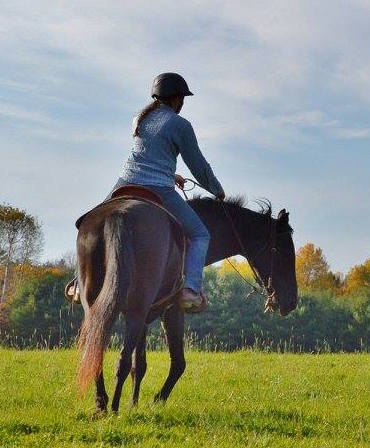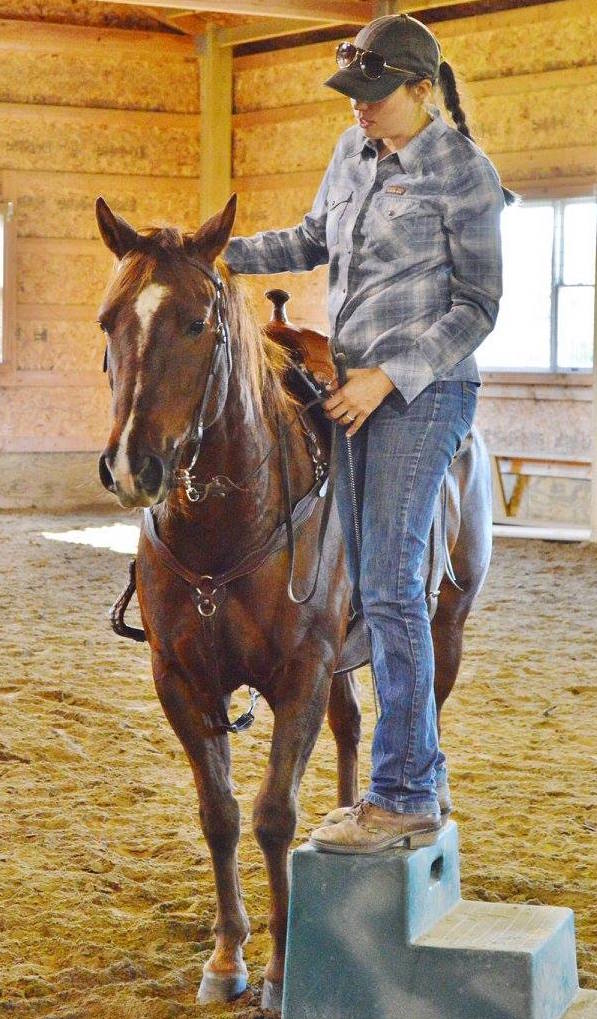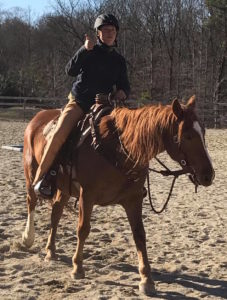 The horses we get in training at Bar T Horsemanship undergo considerable changes in their lives while they’re with us. They leave their normal routine to stay in a strange place with new horses and people. Not only is their environment different, but their treatment is usually a lot different.
The horses we get in training at Bar T Horsemanship undergo considerable changes in their lives while they’re with us. They leave their normal routine to stay in a strange place with new horses and people. Not only is their environment different, but their treatment is usually a lot different.
- Scared horses learn to face and accept the things they’ve run from.
- Spoiled horses learn to become part of a team and put in effort toward a common goal.
Most horses adjust well to a structured learning environment, but the horses I feel the most sorry for are the spoiled ones.

Photo by Julie Kenney
We don’t always know what a horse has experienced. People can give you an account of what ‘horrendous’ episodes it has suffered through, or how much groundwork it’s already learned. But the horse gives us the truest picture.
Some of these horses are a lot like a spoiled teenagers, laying around on their parents couch:
- They don’t work jobs.
- They don’t take out the trash.
- They sleep in and wake up at noon expecting to be fed.
Their well-meaning parents tip toe around them and cater to their needs, yet feel frustrated. When they need their rude teen to help out around the house, they run into a fight. Maybe the parent wins the fight and manages to get the kid to get up and doing the dishes. But both build up resentment and there is no “money put in the bank” of this relationship to draw on later when it’s really important.

Photo by Julie Kenney
Spoiled horses similarly have owners tip toe around them and cater to them:
- They won’t move over in their stall, so people go around them.
- They don’t lower their heads to be haltered.
- They turn their hind ends toward their owner.
The well-meaning person moves around the horse and reaches up high to secure a halter.
Some additional Spoiled Horse Symptoms & Consequences:
- The horse bangs on his stall to be fed, so the owner comes running to quiet him down.
- It paces or gets squirrel-y in the trailer when they arrive to a barn, so it gets immediately let out.
- It’s restless with hoof trimming, so the owner feed treats in hopes this will keep it quiet.
This horse is not intentionally being bad. It has learned what works and what gets results. When it arrives here, suddenly none of those behaviors work anymore.
Imagine the confusion and frustration this poor horse feels. Sometimes I think they feel everything they do is wrong.
If they’ve been using these behaviors for a long time, it can take a while for them to try something new.
They don’t have a lot of try, because they have not had to try.
 They also have very little confidence, because their owners’ tip-toeing has robbed them of new experiences and skill-building. When put in challenging situations, these horses have no foundation to draw on except the one they know: Refuse or Resist.
They also have very little confidence, because their owners’ tip-toeing has robbed them of new experiences and skill-building. When put in challenging situations, these horses have no foundation to draw on except the one they know: Refuse or Resist.
I know without a doubt that when these horses find a leader, partner, and friend waiting for them, then they are more than willing to drop their old habits. They feel more secure and confident when things are consistent and expectations are reinforced. They can become eager to ride, instead of resentful and resistant. They can find meaning in jobs and confidence in their abilities.
These owners love their horses. They may feel frustrated with some of their behaviors, but they bring them to training because they care about them. My advice to them is to set their horses ahead in life.
 Provide good, consistent direction.
Provide good, consistent direction.- Teach them to move around you, instead of the other way around.
- Teach them what’s going to be expected of down the road.
- Don’t spoil them now and hope for cooperation later.
- Give them experiences of going different places and doing different things.
- Create a healthy, mentally balanced horse.
When these horses come for training, they won’t feel beat up by the world. They can transition into their education smoothly and happily.
You see these spoiled horses everywhere, but usually the handler/owner just doesn’t realize that they are letting their horse’s behavior change the handler’s behavior. BUT, it is important to realize that it isn’t the horse’s fault; he is only doing what he’s been allowed to do. That is the crux of the issue. Horses are then labeled as bad, naughty, rotten, disrespectful, and even dangerous…and the cycle continues. Great job on the article, Amy, and all you do to help horses. Hopefully readers will have a “lightbulb” moment and seek out some help with themselves and their horse.
Wow does this ever speak to me–thank you!
Most of us harbor vivid examples from Amy’s list above. Fresh from an Amy Skinner Clinic, she says, and I paraphrase, “we don’t do it to intentionally to be mean…. just choose something, whether a circle, a trail ride, loading, a barn habit, and make it better. Ask yourself, ‘ is this circle, habit, etc better today than the previous one/yesterday?’ That is the way to improve.” Good advice, Amy.
Great post Amy! I think one of your most important points is to be consistent. Many of us tend to reflect how our day is going to our horses. Are you rushed? Then we tend to rush our horses. Distracted by problems at work? Then we’re distracted and inconsistent with our horses.
In working around the horses in stalls, I don’t want them to move unless I signal movement. I’ve taken Dr. Bowker’s guidance from the Summit to heart and I’m picking hooves every day. I want my horses to stand still in the stall while I move from foot to foot. If I want a horse to move, I’ll cup my hand and touch the horse with the tips of my fingers. The horse then moves that part — neck, shoulders, hihd quarters — away from the pressure. It’s a clear signal that’s different from a pat on the neck or the feel of a brush.
It’s easy sometimes to say, “I’m going to fix this “spoiled horse” problem with a crop or a rope end. But you want to give the horse a consistent, light signal to do the right thing before you firm up.
Thanks again for this article and thanks for your work at the Summit.
VERY well expressed, Amy! Impressive consolidation of important observations as a horse trainer recognizing that re-orienting the horse is the “do-able” part of the equation but changing the behavior of the well-meaning human is the big challenge. I shall look forward to more of your posts!